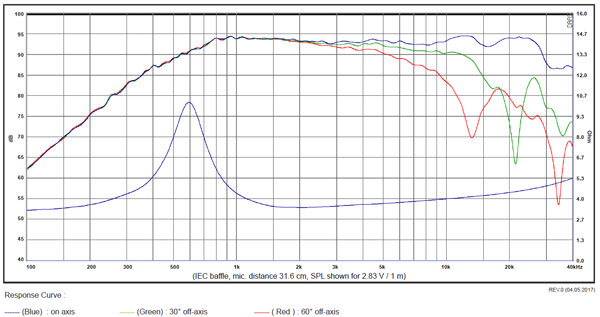OK folks. Listen up. Here's WHY active crossovers are so very much better than passive. A single loudspeaker driver is an inductor, and provides a frequency dependent, reactive load to an amplifier. Looking at the image here, the blue line on the bottom is the frequency dependent impedance curve for an SB Acoustics SB29RDAC Ring Dome Tweeter, and it typical of any dynamic tweeter. As you can see, it is anything but flat, yet it is listed as having a 4 ohm impedance. It's 4 ohms at about 1200 hz, but at 600 hz, has an impedance of nearly 10 ohms.
Now if you put a passive crossover circuit in front of it, you add capacitors, resistors and inductors, which then give you a frequency dependent impedance curve which looks like a Coney Island roller coaster. And that's just for a tweeter high-pass circuit.
Now when you add in mid and bass drivers, with high and low pass filters there... It's a real mess. But we're not done there yet. Nope. Many of your extreme hi-end loudspeakers add in equalization to their crossover designs, which makes that impedance curve even worse. This is very hard for an amp to properly manage. That's why people drop many, many thousands of dollars on things like Krell, Threshhold, Bryston, or Rowland Research solid state power amps.
Now when you use an active crossover, an amp channel only has to manage a single driver. There's no passive, reactive component in between the amp and the loudspeaker driver. Then you don't need a megabuck amp to deal with it.
All of the Linkwitz loudspeaker designs use active crossovers. Earlier designs used analog crossovers, but his last designs were all digital crossovers. There are some digital crossovers that offer DSP EQ, which allows you to tailor the total system response for the room you are in. Then you're not just limited to whatever sound your speakers give you in the room you're stuck with.
The lowest cost active crossovers are typically pro grade, from manufacturers like Behringer, dbx, Rane or even Nady. There are many manufacturers. Some of the best known home audio digital crossovers are from miniDSP.
Another major benefit is that you can use much, much lower powered amps when you use active crossovers. A lot of power is wasted having to push through a passive crossover. You really don't need to push many watts into a tweeter or mid-range driver to get a lot of level out. You could even run a single ended tube amp on your tweeter, and a mid-level tube power amp on your mid-range driver, and a solid state amp for the bass driver. You have a lot of options.
So instead of dropping the Big Bux on some gigantic extreme power amp, you could spend much less on an active crossover and the various much more modestly priced amps of your choice.



